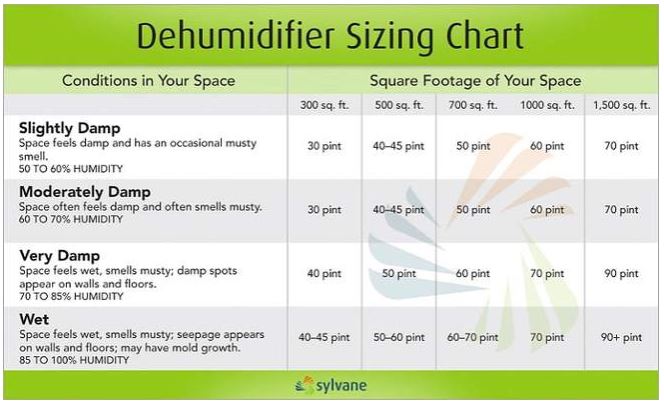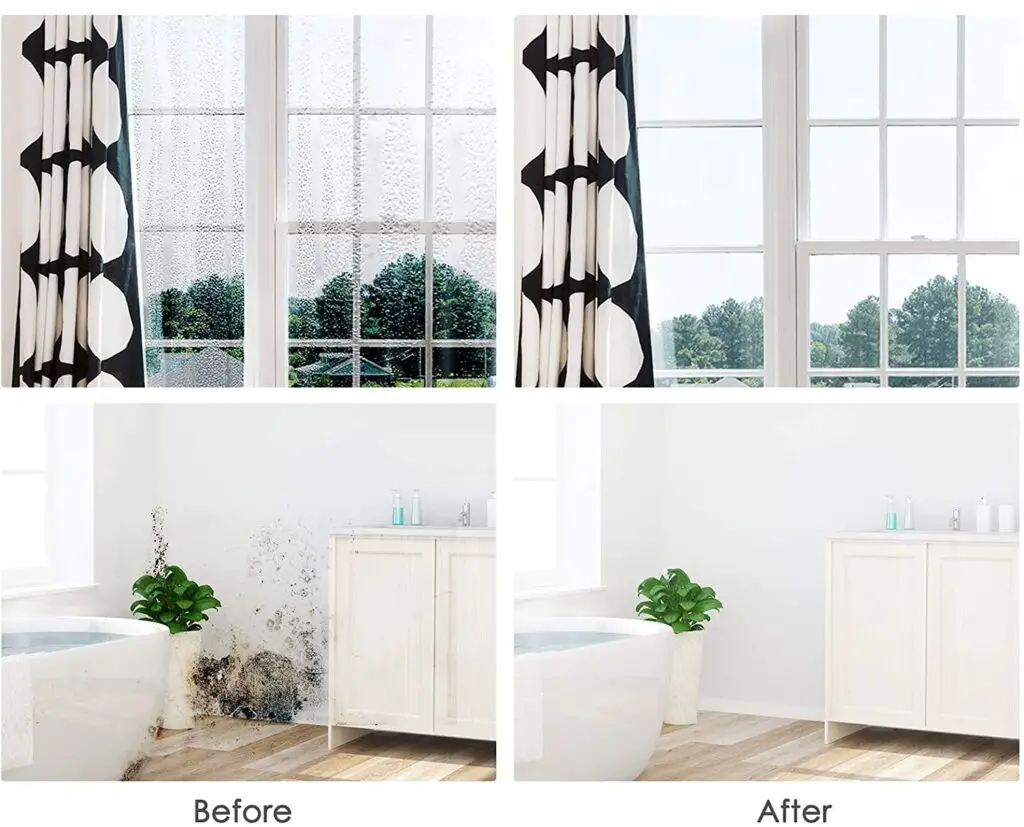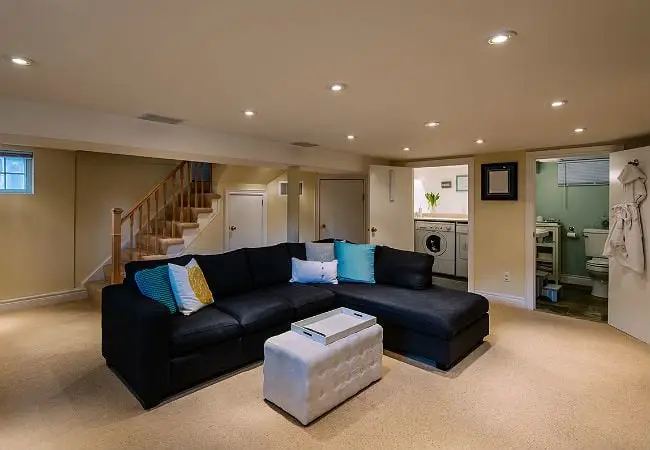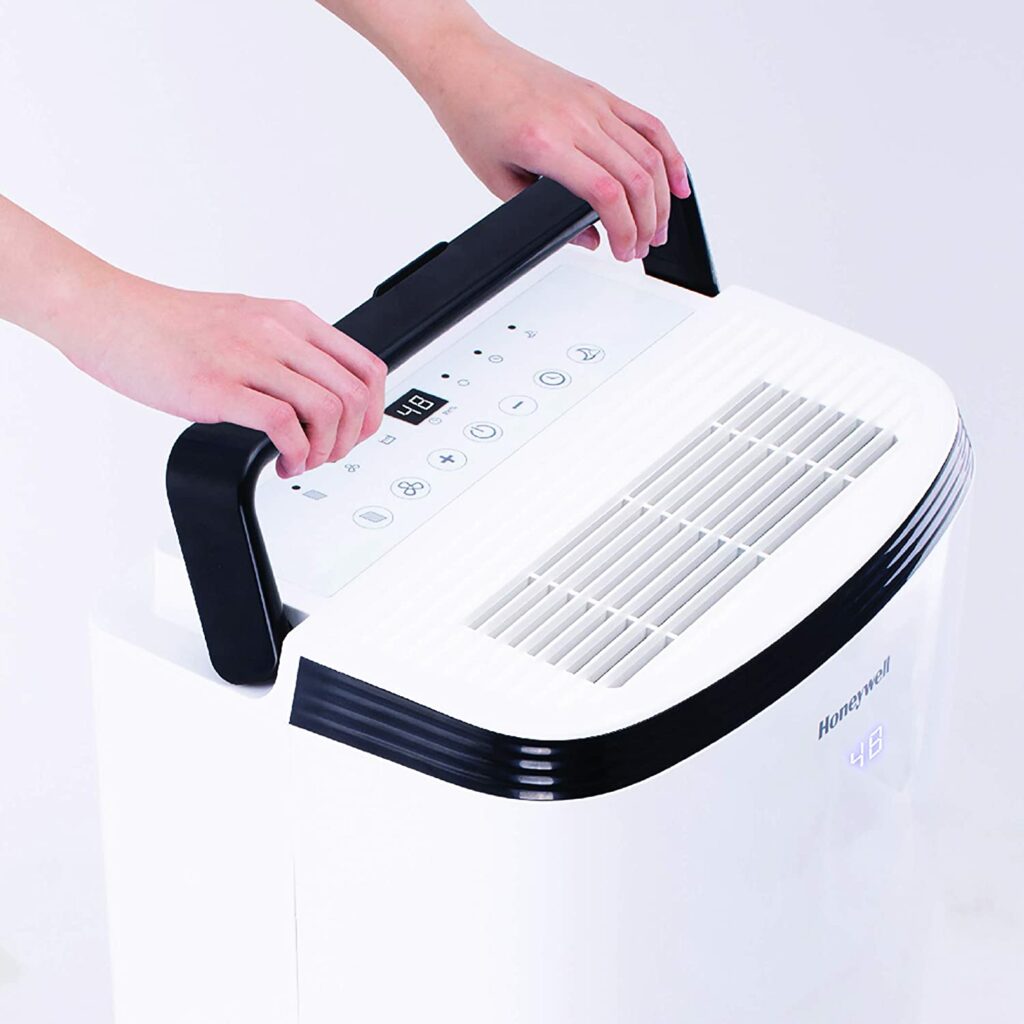When people think of a dehumidifier, they tend to think of hot, high, damp spaces filled with humidity. Keep in mind though that wet and cold climates sometimes also suffer from too much moisture in the air.
To deal with this problem, technology has given birth to low-temperature dehumidifiers. These are engineered specifically to operate at an optimal level in cool climates.
However, finding the best low-temperature humidifier can be difficult, which is why we have decided to help you out. Mentioned below is all you need to know about this variety of dehumidifiers along with the top products present on the market.
At a Glance: Our Top Picks for Low-Temperature Dehumidifiers
- OUR TOP PICK: Honeywell TP50WKN
- RUNNER-UP: Colzer HD08C
- Honeywell TP70PWKN
Comparison of the Best Low-Temperature Dehumidifiers
| IMAGE | PRODUCT | |
|---|---|---|
Our Top Pick  |
| View Latest Price → |
 |
| View Latest Price → |
 |
| View Latest Price → |
 |
| View Latest Price → |
 |
| View Latest Price → |
How to Choose a Low-Temperature Dehumidifier
Choosing the right kind of dehumidifier requires proper research and time from your end. However, as a general rule, make sure to look out for the following characteristics when making a purchase.
Dehumidifier Size
Dehumidifiers that are used commercially come in three different sizes; 70 pints, 50 pints, and 30 pints. This size describes how much moisture these units can capture in one day and have no relation to any physical availability, dimension or the capacity of the reservoir. Instead, they depend on the room you need to place them in.
A smaller room will be perfect for a 30-pint unit, whereas a medium room can make use of a 50-pint unit. Similarly, you can use a 70-pint unit for an entire household as well as large bedrooms. These large dehumidifiers do not run for a long time, and this helps in prolonging their lifespan. However, if you’re on a short budget, you can always go for a 30-pint or 50-pint dehumidifier, since they are less expensive.

Quiet Operation
Noise of any kind can be a real nuisance, and when investing in a product such as a dehumidifier that works all through the night, it is essential to consider this aspect. Dehumidifiers that come with two different fan speeds can be quiet at low humidity levels; however, some units make slight noise even at the low setting.
It is a good idea to purchase a dehumidifier that is extremely quiet and does not make any noise at all. This way, you can enjoy their high functionality along with a night of good sleep.
Automatic Shutoff
Dehumidifiers can run for a long time at low temperatures. However, running of a unit for prolonged hours without a full tub can be harmful. This can weaken it and even ruin the mechanical system of the dehumidifier.
So, it is essential that you get a humidifier that comes with a timer or an automatic shutoff feature. This allows you to sleep peacefully without getting up in the middle of the night to turn it off or check the tank.
Some dehumidifiers also come with an indicator light that tells you when it needs to be refilled.
Review of the Best Low-Temperature Dehumidifiers
Now that you’re aware of what to look for and why dehumidifiers are so helpful, you can find the best low-temperature dehumidifiers present in the market. Here are five units that we think are truly worth investing in.
Best Overall
Honeywell TP50WKN
Product Ratings
Affordability:
Cost Efficiency:
Warranty:
Space Efficiency:
Portability:
How We Determined These Scores
We may earn commission from purchases made from our links, at no additional cost to you
Quick Product Specs:
Pints (DOE): 50
Warranty Length: 5 years
Size & Weight: 10.5×13.2×20.1”; 34 lbs.
Tank Capacity: 3.3 Liters
Decibel Level: 50 dB
Review
As one of the most reputable names in the business, Honeywell provides yet another quality low-temperature humidifier that hits the coveted 10-star mark. While an LED display and a smart turn-on feature highlight the offerings of the TP50WKN, the unit’s cost efficiency and space efficiency ratings reach the stellar 4.5-star range. Add in handles capable of holding up to 150 pounds and a cord winder, and this unit brings everything that Honeywell is known for a full circle.
Bottom Line
While this unit takes a small hit with a 3.5-star affordability rating, its 5-star warranty, added features, and strong portability ranking makes it one of the best options in low temperature. From Alaska to Minnesota, the Honeywell TP50WKN takes the crown, and with good reason.
Pros
LED display
3,000 sq. ft. of coverage
Easy storage thanks to a cord winder
Easy water disposal thanks to anti-spill design
Smart turn-on feature that fires up the unit when it senses a rise in humidity
Cons
Drainage issues with the hose connector
More expensive than some of the other low-temperature units
Runner-up
Colzer HD08C

Product Ratings
Affordability:
Cost Efficiency:
Warranty:
Space Efficiency:
Portability:
How We Determined These Scores
We may earn commission from purchases made from our links, at no additional cost to you
Quick Product Specs:
Pints (DOE): 50
Warranty Length: 2 years
Size & Weight: 20.5×14.5×11”; 28.8 lbs.
Tank Capacity: 2.49 Liters
Decibel Level: N/A
Review
Although Colzer may not have the same reputation or brand reputation as Honeywell, it still has one of the best dehumidifying units for low temperatures. In fact, it beats the Honeywell unit with a 5-star cost efficiency rating, although it underperforms with a 3.5-star space efficiency rating. But with 3,500 sq. ft. of coverage, four casters and two handles for portability, and more coverage area, it’s a great option that won’t break the bank.
Bottom Line
Sometimes, a brand name unit is just that: a brand name. While Colzer may not be a household name, its HD08C dehumidifier is a proven workhorse in low temperatures. Plus, it adds three dehumidification modes, smart control, and a dry mode for drying clothes on top of its 4-star portability rating. It’s versatile, it’s smart, it’s reliable. You can’t get much better than that trifecta.
Pros
A child lock feature
Programmable timer
Dual drainage options
3,500 sq. ft. of coverage
Maximum control with three dehumidifier settings
Cons
Sensor malfunctions may occur on occasion
Small tank capacity may require frequent replacement of the tank
Honeywell TP70WKN
Product Ratings
Affordability:
Cost Efficiency:
Warranty:
Space Efficiency:
Portability:
How We Determined These Scores
We may earn commission from purchases made from our links, at no additional cost to you
Quick Product Specs:
Pints (DOE): 70
Warranty Length: 5 years
Size & Weight: 12.4×15.75×25.4”; 48.95 lbs.
Tank Capacity: 7.9 Liters
Decibel Level: 51 dB
Review
The Honeywell TP70WKN is the larger sibling of this list’s #1 ranking, but it isn’t without some great features and amenities. A 24-hour programmable time and a full tank and filter alert highlight the best specs of this unit, but the features don’t end there.
In low temperatures, an internal pump is everything. You don’t want to get up in the middle of the night to change the water tray. And that’s what makes this an even more impressive entry into the low-temperature dehumidifier realm. While it only earns a 3-star affordability rating, the 4.5-star cost efficiency rating more than makes up for the extra cash you spend on this unit.
Bottom Line
Although this unit has handles and wheels, it’s a tad on the heavy side, weighing in at nearly 50 pounds. It only earns a 2-star rating for portability, as lugging this little monster up the stairs can prove daunting for some buyers. Still, with its ability to operate in near-freezing temperatures efficiently and effectively, the Honeywell TP70WKN earns a spot on this list with few drawbacks.
Pros
Energy Star certified
Top-notch customer service
24-hour energy-saving timer
Full tank and filter cleaning alert
Excellent water removal capacity
Cons
Built-in pump has issues
Connection between drainage hose and pump can break
Midea MAD50P1WS

Product Ratings
Affordability:
Cost Efficiency:
Warranty:
Space Efficiency:
Portability:
How We Determined These Scores
We may earn commission from purchases made from our links, at no additional cost to you
Quick Product Specs:
Pints (DOE): 70
Warranty Length: 1 year
Size & Weight: 24.29×15.94×11.54”; 41 lbs.
Tank Capacity: 18 Liters
Decibel Level: 54.5 dB
Review
The Midea MAD50P1WS earns the fourth spot on this list because of its cost efficiency rating of 5 stars. With a small investment, this beast will take the moisture out of the air at a fraction of the cost.
Moreover, the Midea provides an auto-drain feature with a 16-foot hose, easily eclipsing the short, flimsy hoses and overworked drainage features that plague many of its competitors. Tack on an Energy Star certification and this beast looks pretty good, even in the most frigid climates.
Bottom Line
For everything it is, the Midea has few drawbacks; however, it has some noise issues, which may make it a poor choice for the bedroom. It’s also a bit bulkier than other units, giving it only a 3.5-star portability rating. Still, this is a solid unit that can take care of moisture issues that may plague your household during the winter.
Pros
Energy Star certified
Programmable timer
Includes a 16-foot hose
Has an auto-draining pump
Turbo fan for extra quick dehumidification
Cons
Rather inefficient in the 70-pint dehumidifier space
Company has a poor track record of honoring warranties
Inofia HD161A

Product Ratings
Affordability:
Cost Efficiency:
Warranty:
Space Efficiency:
Portability:
How We Determined These Scores
We may earn commission from purchases made from our links, at no additional cost to you
Quick Product Specs:
Pints (DOE): 30
Warranty Length: 1 year
Size & Weight: 12.2×8.2×17.3”; 24.9 lbs.
Tank Capacity: 1.89 Liters
Decibel Level: 46 dB
Review
The Inofia HD161A may not have the prestige and brand loyalty as Honeywell or some of the other units on this list, but it’s got all the features to stand up to the test. With a 4.5-star affordability rating mixed with 4-star ratings for space efficiency and cost efficiency, it’s an excellent choice, even in the face of fierce competition.
Bottom Line
While a 2-star, 1-year warranty plagues the Inofia HD161A, its other features more than make up for it. Auto-restart and auto-defrost features are ideal for low temperatures. And with a super-low hum when it’s in operation, you can forget about the moisture while you get a good night’s sleep.
Pros
Super quiet
1,056 sq. ft. of coverage
Avoids damage with an auto-defrost mode
Features auto-stop and auto-restart modes
Has an audible warning that the water tank needs replacement
Cons
Not a great option for larger homes
The amount of coverage may not be as big as advertised
What is a Low-Temperature Dehumidifier Best For?
A low-temperature dehumidifier has several benefits that make it an ideal product to invest in. These units help in making your household inhospitable to allergens such as mold, dust mites, mildew, and germs. Since these units do not make too much noise, they can run efficiently in the background without disturbing anyone.
Moreover, since they work at a low temperature, they can work for a long period of time and reduce the possibility of developing mold on your clothes and furniture. They even help in getting rid of rotting smells and any other unpleasant odors. All of these benefits make it ideal for you to buy a low-temperature dehumidifier, and since they are energy efficient, you don’t have to worry much about these adding to your utility bill.

What Makes a Dehumidifier Great for Use in Low Temperatures?
Standard dehumidifiers can handle the humidity in average or high temperatures, but the condensers may struggle with wet climates or cold seasons. Here’s a look at why low-temperature units are perfect for these conditions.
Designed for Cold Rooms
The most significant benefit is that manufacturers build these dehumidifiers to withstand cold temperatures. They work best in your chilliest rooms that seldom receive heat, such as garages and basements. You’d be surprised how much humidity can rise in these spaces.
Protection from Mold and Mildew
Dark rooms with high humidity are catalysts for mold and mildew spores. If left unattended, they can rapidly grow, causing damage to structural components and creating foul odors. Dehumidifiers not only remove the moisture in the air that allows for these conditions to proliferate, but they also help with air circulation to remove the bad smells.

Eliminates Bacteria
Besides causing illnesses, harmful microbes can make it difficult to breathe. Cold rooms are havens for these lifeforms, eventually leading to serious health conditions like sick building syndrome. Air conditioning systems sometimes enable airborne diseases to travel around the office or home. Low-temperature dehumidifiers can solve this issue for you.
What is a Low-Temperature Dehumidifier, and How Does it Work?
These appliances work exceptionally well in regions with wet weather, cold temperatures, and high humidity. Standard units can handle anything above 60℉, while low-temperature dehumidifiers can function as far down as 40℉. The primary reason is that the components are designed to withstand these conditions without icing up.
There are different types of dehumidifiers. For instance, some have condensers, while others work with heat pumps. They operate by extracting the humidity from the air in various ways, pushing dry air out of an exhaust that also serves to warm the room.
Low-Temp vs High-Temp Dehumidifiers: How Do They Compare?
Are you wondering why you should swap out your high-temp dehumidifier for a low-temp version? Here are a few factors to consider.
Different Climates
The most obvious difference is that one can only handle temperatures above 60℉ while the other can drop lower. High humidity also appears in wet climates, and you’ll suffer from the same problems, especially in basements, attics, and garages. The components may be similar, but a low-temperature unit will function differently to handle the colder environment.
Defrosting Time
You can still use high-temperature refrigerant humidifiers for colder climates up to a certain degree. The problem is that the time it takes to defrost the water into the pan will take longer, which is why the low-temp option is recommended. The defrost cycle is shorter, leading to quicker dehumidification.
Suitable Locations
You may have a warm home with a gorgeous patio, with the sun beaming in while you relax under one of the best high-speed ceiling fans. However, your basement may hold a lower ambient temperature. So while you’re running a high-temperature dehumidifier in your living room, it may not be helping the colder spaces.

Life Expectancy
One of the top reasons not to use high-temp units in cold climates is the damage it can cause to the internal components. You’ll drastically reduce the device’s lifespan, and you’ll pay more than is needed for maintenance or repair costs. It will also work harder to remove humidity, so expect higher utility bills.
Aspects to Consider Before Buying a Low-Temp Dehumidifier
Before you head out and buy one of our recommended low-temperature dehumidifiers, there are a few aspects you should look at first.
Coverage
It’s not enough to merely find a dehumidifier that can handle low temperatures. If you have a large basement or storage room, you’ll need to ensure the unit’s capacity. 70-pint machines can remove humidity from bigger spaces than 50-pint units.
Water Tank and Drainage
The water tank size is also a significant factor, as it indicates how quickly it will become full. You’ll need to change smaller tanks more often. Even better, if the dehumidifier has a drainage pump and hose then it’ll do this for you.

Weight and Size
The dehumidifier’s size also comes into play. Your room may be small, so you won’t have room for a massive unit. You also shouldn’t purchase a heavy appliance if you intend to move it around your home periodically during the day.
Warranty
Not all manufacturers supply a warranty for their components. We recommend you find a dehumidifier that does have one. In low temperatures, parts may fail sooner than their intended lifespan. It will help if you can receive replacements at no extra cost.
Conclusion
We hope one of these five dehumidifiers ends up being the perfect unit for your home and we hope that this guide helped make your search easier and less time-consuming. Invest in the right kind of dehumidifier and make sure you get your money’s worth.
People Also Ask
Do you have a few questions remaining after reading our guide? Let’s see if we can answer them for you.
The best time to use a low-temperature dehumidifier is in regions that drop below 60℉. Standard units will have longer defrosting times, causing damage to their components in the long run. If you see mildew or mold forming in your rooms, it’s time to buy one of these machines.
You’ll need to place it in a central location to cover as much of the space as possible. Ensure that you keep the humidity as close to 50% as possible. If there’s a water tank, you’ll need to empty it as soon as it reaches a specific level.
If the humidity is high in winter, you need one. Dampness can spread in your garage or basement, resulting in bacteria, mold, or mildew. It can also cause damage to your walls and floors.
You can set it to any amount below 60%. The recommended level is between 40% and 50%. If you’re looking for maximum comfort, you can aim for between 30% and 60%.
Low-grain refrigerants excel in commercial environments with harsh conditions. They can withstand both low and dry conditions without suffering any damage. However, if you’re looking to place a dehumidifier in a residential space, you’re better off with a desiccant unit.
If you find the condenser coils or evaporator, the chances are that there isn’t enough air blowing over them. You should remove the cover and check the fan, ensuring that no dust or lint blocks it. Make sure that the blower wheel isn’t damaged or dented. You can also heat the room with a separate device.
